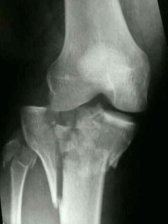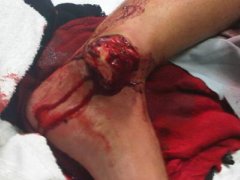|
Fracture TypesThis section will discuss the many different fracture types that are seen almost every day. As was mentioned in our introductory page, bone injuries are described based upon the bone involved, the mechanism of injury, the presence/absence of displacement, angulation, compression, rotation and how a particular fracture type relates to the middling of the body’s axis or center.
As we progress, we’ll also touch upon fractures that are named after the person who discovered them and show how those names also help to identify a specific break.
This refers to an injury that has remained within the protective layers of skin and underlying tissues. There is no direct communication of the bone or fragment(s) with the outside environment.
Open fractures are more commonly nown as "compound Fractures. Be warned, the picture at left is a bit graphic, but it does show the inherent severity of this fracture type. Here, the tibia (shin bone) is protruding throuogh the skin.
Open injury types are also referred to as “compound fractures”. These injuries are potentially very serious because they have a greatly increased risk for infection. Open fractures can occur anywhere along a bone, not just at a joint. When they do involve the joint, it becomes a more difficult situation to deal with, because several concerns arise: Restoring the joint integrity, preventing infection and minimizing traumatic effects of the injury to the joint cartilage must all be addressd...not ot mention any soft tissue, nerve or blood vessel injuries that often accompany injuries of thids nature...and the outcomes can be much less satisfactory than simple fractures.
This type refers to a break that has occurred, but has not disrupted the normal position and alignment of the involved bone. Occasionally, this injury type may even be difficult to visualize on x-ray and are sometime referred to as “Hairline”.
This term describes a bone break that has resulted in the formation of several fragments or pieces of bone at the site of the break. 
Frequently, one sees "comminution" (fragmenting) of fractures that involve higher velocity injuries, such as motor vehicle trauma and gunshot wounds. These fractures can be extremely challenging to deal with. Often times there is some degree of bone loss, or empty spaces ("voids") where pieces would notmally occupy. The x-ray at right shows a badly comminuted tibialplateau fracture the is also an "intra-articular" (involving the joint itself, see below)injury because of the significant disruption of the joint surfaces. Restoring joint surfaces as best as possible is critical in these injuries, as is restoring more normal alignment and position of the bone.
When a bone’s normal position (which is largely straight) is altered in such a way as to create an angle, or change an angle to something different, the break is said to be angulated. The direction of the resultant angle, either towards or away from the body’s center mass, also results in another descriptive name: “Varus” or “Valgus”. These terms are used primarily in describing injuries to the upper and lower extremities, where varus denotes a bow-legged angle and valgus, a knock-knee angle. Angulation can also be described in terms of front to back as well, with “anterior angulation” referring to angling toward the front of the body and “posterior angulation” towards the back.
There are so many more variations of types, and they can get more technical.
Intra-articular fractures are those injuries that involve and extend into the actual joint compartment(s) causing injury, and sometimes deformity, to the joint cartilage surfaces. Think of a joint surface as a china plate. Now, imagine that plate being broken and glued together. Even though the pieces fit nicely after repairing it, if you rub your fingers over the plate, the crack lines can still be felt. The same can be said for intra-articular fractures. Best case scenarios show that even though many joint surface injuries can be restored to very good condition, they're never perfect, and never return to "pre-injury" normal states.
Leave Fracture Types, Go to Fractures
|

"We hope you enjoy your journey through Bone and Joint Pain.com"
 This injury has resulted in a break in the protective continuity of the skin and underlying tissues. There is a direct communication between the bone and fragment(s) with the outside environment.
This injury has resulted in a break in the protective continuity of the skin and underlying tissues. There is a direct communication between the bone and fragment(s) with the outside environment. 